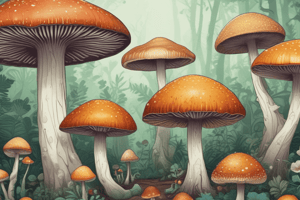Podcast
Questions and Answers
What is the role of fungi in our biosphere?
What is the role of fungi in our biosphere?
- They are responsible for causing diseases
- They are able to move on their own
- They break down dead organic matter and recycle nutrients (correct)
- They manufacture their own food
What is a characteristic of fungi?
What is a characteristic of fungi?
- They are always harmful to humans
- They are able to manufacture their own food
- They are able to move on their own
- They are multicellular and reproduce with spores (correct)
What is an example of a useful fungus?
What is an example of a useful fungus?
- Penicillin (correct)
- Bread mildew
- Truffles
- All of the above
How do fungi reproduce?
How do fungi reproduce?
What is yeast commonly used for?
What is yeast commonly used for?
What characteristic do all protists have in common?
What characteristic do all protists have in common?
What is a characteristic of vertebrate animals?
What is a characteristic of vertebrate animals?
What is a characteristic of bacteria?
What is a characteristic of bacteria?
What is true about plankton?
What is true about plankton?
What is the basis for subdividing vertebrate animals into five classes?
What is the basis for subdividing vertebrate animals into five classes?
Flashcards are hidden until you start studying
Study Notes
Fungi
- Fungi play a crucial role in the ecosystem by breaking down dead organic matter, releasing nutrients back into the soil, and allowing plants to utilize them.
- Some fungi can cause diseases, while others, like penicillin, are beneficial to humans.
- Yeast, a type of fungi, is used to make bread rise and to ferment beer and wine.
- Characteristics of fungi:
- Unicellular and multicellular organisms
- Cannot manufacture their own food
- Reproduce with spores
- Cannot move
Bacteria
- Bacteria are microscopic organisms, requiring a microscope to be seen.
- Characteristics of bacteria:
- Some may move
- Can manufacture their own food (some species)
- Divide to become more
- Bacteria are alive, as they exhibit certain life processes.
Protista
- Protista are microscopic organisms, requiring a microscope to be seen.
- Characteristics of protista:
- Unicellular, but not always
- Eukaryotic cells with a membrane around the core
- Need a fluid medium to live
- Protista, like Plankton, are unable to eat and must make their own food through photosynthesis.
Vertebrates
-
Animals are classified into vertebrates (with a spine) and invertebrates (without a spine).
-
Vertebrate animals are subdivided into five classes: fish, amphibians, reptiles, birds, and mammals.
-
Characteristics of vertebrates:
- Have a vertebral column (spine) with a cavity containing nerve cells
- Skeletons are made of bone
- Have an endoskeleton
-
Examples of vertebrates: dolphin, dog, goose, and others.
Studying That Suits You
Use AI to generate personalized quizzes and flashcards to suit your learning preferences.




